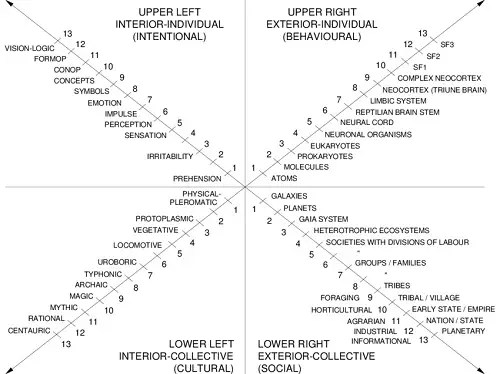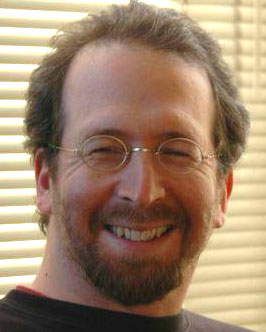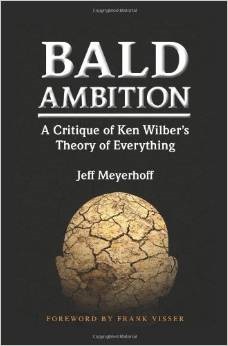|
TRANSLATE THIS ARTICLE
Integral World: Exploring Theories of Everything
An independent forum for a critical discussion of the integral philosophy of Ken Wilber
SEE MORE ESSAYS WRITTEN BY JEFF MEYERHOFF

Holarchy
Bald Ambition, Chapter 1,
Section C: The Four Quadrants
Jeff Meyerhoff
The four quadrant division is an ontological division. It describes the essential kinds of things in the Kosmos.
Wilber maps the evolutionary unfolding of matter, life, mind and spirit from the Big Bang to the present day and beyond. To understand his conception picture x and y axes intersecting at right angles. The point of intersection represents the Big Bang. Concentric circles radiating out from the point of intersection represent the stages of evolution, with each widening ring a chronologically later and more advanced level of holonic development. Each holon has four aspects represented by the four quadrants created by the intersecting x and y axes. The upper right quadrant is the exterior of the individual holon's development (e.g. an atom, a cell, a brain). It is what you see on the surface or exterior of the individual holon. The lower right quadrant is the exterior aspect of the holon's social development (e.g. galaxies, families, the nation state). The upper left quadrant is the interior or the subjective side of the individual holon's development (e.g. sensation, impulse, cognition). This we have to intuit or interpret since it is inside of or interior to the holon. Finally, the lower left quadrant is the interior or inter-subjectivity of the holon's social development (e.g. magical, mythical or rational world-views). Each successive wave of evolutionary development transcends and includes all the stages that precede it. For example, the individual animal subsumes atoms within molecules within cells within the brain. Each higher level provides a wider context in which the lower levels exist.
Since the four quadrants, holons and the 20 tenets are interrelated, Edwards,' Goddard's and Smith's criticisms of the latter two have implications for the former. The four quadrant map, as originally drawn in SES, depicted the four different aspects of each holon. Each holon had an individual, social, exterior and interior aspect. Yet Wilber routinely referred to individual and social holons, not individual and social aspects of holons. This may seem to be a minor linguistic shortcut, but Wilber's commentators have demonstrated in great detail how this semantic slip reveals what is crucially problematic about Wilber's four quadrant model, causing Andrew Smith to recently conclude “that the four-quadrant model, in its original form, is dead.”[1] Adding to this confusion regarding individual and social holons and individual and social aspects of some third thing called “a holon,” is another aspect of each holon described in tenet 2 which is its characterization as being somewhere on the self-preservation/self-adaptation or agency/ communion spectrum. Depending on how these terms are defined it is not clear how to distinguish between agency and individuality on the one hand, and sociality and communion on the other. If agency and communion are interpreted as another set of aspects of each holon, does that require further axes and quadrants in order to map the character of each holon? This has led Edwards and Goddard to construct multiple and more complicated maps, and Smith to reassert the effectiveness of his one-scale model of holarchy.
Smith's criticism of the distinction between individual and social holons makes the separation of the upper right and lower right quadrants fall apart. The details of this criticism have been described elsewhere;[2] Smith's conclusion is that “the criteria that Wilber and Kofman provide for distinguishing individual and social holons are useless. Some of these criteria either fail to make the distinction at all -- as shown by the fact that they apply to some of their listed examples of individual holons (“molecules, cells, organisms”) as aptly as they do to social holons; others can't be applied at all.”[3]
Edwards agrees that the Wilber-Kofman revisions are mistaken, but unlike Smith thinks them unnecessary since the original four quadrant model and holon definitions in SES can be retained as long as they are applied consistently. This more consistent application, however, requires creating two four quadrant models in order to do justice to both individual and social holons, each of which has four aspects.
Smith also points out an interesting contradiction in Wilber's four quadrant division. He notes that Wilber, like most holarchic thinkers, observes that the Kosmos unfolds from matter to life to mind to spirit. Mind emerges from life, yet on every level of Wilber's four quadrants mind and life are present together. Do we conceive of the rational mind as emerging from the brain and therefore a higher emergent development or do we see it as the individual interior aspect of the individual exterior brain, both on the same developmental level?
This asymmetry between the exterior brain and the interior mind is also found among individual and social holons. The cells of the brain demonstrate a relatively high degree of interactive or social connection, more so than lower invertebrates which are on a higher developmental level than cells. According to Wilber's four quadrant model, the sophistication of social interactions should be greater for the lower invertebrates than for the relatively lowly cell, but it is not.[4]
The relationship between the mind and the brain is a contentious issue in a number of fields. Wilber has decided that they are two aspects of a third thing, the holon. But if his model is supposed to integrate as many other theories as it can, isn't it prejudiced against many other ways of understanding the mind/brain relationship? Since no consensus in cognitive science or the philosophy of mind has been reached regarding the status of consciousness, his map which takes a definitive stand on the mind/brain relationship cannot include the orienting generalizations or truths determined by these fields of study.
The four quadrant division is an ontological division. It describes the essential kinds of things in the Kosmos. On top of these ontological divisions, Wilber overlays a methodological and an epistemological division. The methodological division assumes that each of these four aspects of the holon needs a particular method of knowledge acquisition. They are different kinds of things and so require different methods to know them. The epistemological division assumes that these four quads have differing criteria of validity.[5]
Wilber claims that the character of the exteriors of the Right Hand side and the interiors of the Left Hand side of the holarchy each require a distinct methodology in order to gain knowledge of them. The elements on the right hand side have in common that the object of inquiry is on the exterior and can be read off the surface. We can all share in looking at a cell, a brain, a village. The left hand side is different because the object of inquiry is subjective and internal contents must be interpreted to be known. So Wilber is overlaying the ontological division of interior left hand side and exterior right hand side with a methodological division. The exteriors require structural and functional methodologies used in the natural sciences and applied to the social sciences and humanities. The interiors require a hermeneutic methodology in order to interpret meaningful content. But in contrast to Wilber's claims, there are quite a few examples of right hand methods used to illuminate left hand objects of inquiry. Claude Levi-Strauss used structuralism to study the myths and world-views of the lower left quadrant in a scientific way. Piaget, who Wilber relies upon greatly to construct his model of individual development, used structural methods and psychological experiments externally verifiable to describe interior worlds. Daniel Dennett makes arguments regarding human subjectivity using scientific research and tries to dispel the illusion of our subjective sense of consciousness or the “Cartesian Theatre.” Emile Durkheim studied suicide using right hand methods and gained insights into society's mental life, the lower left quadrant. Buddhism and phenomenology use a subjective empirical inspection or a “reading off” of the contents of consciousness similar to the empirical methods of the natural sciences. Buddhist practitioners are given the hypothesis that all the contents of consciousness - thoughts, emotions and sensations - are impermanent and then use the mindful experiencing of those contents to either confirm or deny this hypothesis.
Reversing this, there are hermeneutic (interpretive), left hand, methods that are used to study the right hand side. Qualitative sociology is used to study the village, the family and the city. These qualitative methods are not just used to determine the cultural (lower left) aspect of these social groupings, but to understand the kind of social structure present - a lower right (exterior) aspect. More fundamentally, Wilber's original distinction between the exterior-objective of the right hand side and the interior-subjective of the left hand side breaks down because the social exteriors he describes are constituted not just through objective viewing like an atom or a cell, but through the subjective meanings that the participants in the villages and families give them. In some primitive tribes the mother's brother - who we would call the uncle - is regarded by the child as his or her father. What constitutes “the family” here? In many households there is no father or there are two mothers. Are they families? It depends on how we define “family.” This is not an objective determination, but must include how the participants subjectively regard each other. So the two quadrants in this case are inextricably bound. Right hand, scientific, structural-functional researchers occlude this subjective element because it confuses their neat methodology. Wilber reproduces this occlusion by taking for granted the right hand researchers stated method of inquiry.
We see now that the methodologies used to study the different quadrants do not follow Wilber's ascriptions. In fact, the use of differing methodologies in differing domains is one way those methods of study stake out new areas of inquiry. The territories are always being redrawn depending on the success or failure of the contending methods. Epistemological, political and popular success determines the ever ongoing re-mapping which Wilber is trying to fix. He is assuming that there are natural kinds in the world and that they are divided according to his neat four-part division; that they have different essences requiring different methods of study. The philosopher and cognitive scientist, Brian Cantwell Smith describes the way new sciences are describing and explaining aspects of the subjective realm:
Neuroscience is ablaze with excitement about elucidating the phenomenology of consciousness;…mathematical models are being developed of such basic notions as order, autonomy and self; evolutionary accounts are offered of altruism, tribalism and belief; computational models traffic in meaning and interpretation;” and concludes that “Not since the nineteenth century has 'natural science' been restricted to the physical.[6]
Wilber too wants to integrate the subjective and objective sides of reality, but he also wants to preserve the domain of subjectivity by what he contends are inappropriate encroachments by the natural sciences.[7] To integrate these new types of inquiry he would have to redraw his four quadrant map.
On top of the ontological and methodological distinctions, Wilber overlays an even more problematic epistemological division. He states that the differing quadrants have differing criteria of validity. The right hand, exterior side uses propositional truth, the upper left uses sincerity or truthfulness and the lower left uses justness or moral fitness. Yet it's clear that to study all quadrants we need the validity of propositional truth. The developmental sequence that Wilber describes as constituting the upper left quadrant based on Piaget's and Wilber's developmental models is much more dependent on propositional truth than truthfulness and sincerity. Additionally, the judging of sincerity is not only dependent on empathizing and interpreting an individuals depths; a big part of our determination of people's sincerity is whether we think they are lying. This we determine, in part, by whether what they tell us is propositionally true and logically consistent. Likewise, the determination of justness in a society requires propositional truths such as income distribution, changes in real wages over time and the shape of the social structure, all of which refer to social exteriors.
The central criticism of the structural-functional approach in sociology, which supposedly determine value-neutral propositional truths of the right hand exteriors, was that they were unwittingly value-laden, an aspect of the knowledge of the left hand interiors. In history, Hayden White argues that to even write a narrative history of an objective social entity like a state or war-making necessitates a value-system or moral stance. [8]
Instead of having one map in which we fit three overlapping classifications - objects of inquiry, methods and validity claims - we actually have three which don't overlap. In addition, the distinctions which create each of these three maps don't stay in their respective categories. Generally, Wilber writes as if the four aspects of all holons is an ontological division of the Kosmos, but he also argues that the division between the four quadrants is an historical, and so changing, achievement. Seeing it as an historical achievement he could allow the ontological, methodological and epistemological integrations and mergers that I describe; but if he did this he would have to call into question the very divisions upon which his four quadrant model is based.
References
[1] Smith, Andrew P., “Wilber's Eight-fold Way,” at integralworld.net, May 2003.
[2] See Chapter 1, Section A.
[3]Smith, Andrew P., “All for One and One for All,” at integralworld.net, Feb. 2001, p.7.
[4] Smith, Andrew P., “Different Views: Intersubjectivity, Interobjectivity and the Collapse of the Four-Quadrant Model,” at integralworld.net, May 2001.
[5] Wilber, Ken, A Brief History of Everything, (Boston: Shambhala Publications, 1996), Chapter 6.
[6] Cantwell-Smith, Brian, “God, approximately,” Science and the Spiritual Quest edited by W. Mark Richardson et al, (New York: Routledge, 2002), p. 209.
[7] SES, pp. 146-149.
[8] White, Hayden, Metahistory, (Baltimore: Johns Hopkins University Press, 1973).
© Jeff Meyerhoff, 2003
|

 Jeff Meyerhoff, M.A., L.S.W. is the author of "Bald Ambition: A Critique of Ken Wilber's Theory of Everything" and other essays on integral theory. He majored in economics and sociology and has studied philosophy, psychology, politics and spirituality. He's been employed as a social worker for the last 25 years. His weekly radio show, "The Ruminator," is archived at www.wmfo.org. His blog is www.philosophyautobiography.blogspot.com and his email is [email protected].
Jeff Meyerhoff, M.A., L.S.W. is the author of "Bald Ambition: A Critique of Ken Wilber's Theory of Everything" and other essays on integral theory. He majored in economics and sociology and has studied philosophy, psychology, politics and spirituality. He's been employed as a social worker for the last 25 years. His weekly radio show, "The Ruminator," is archived at www.wmfo.org. His blog is www.philosophyautobiography.blogspot.com and his email is [email protected].
